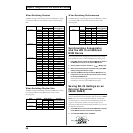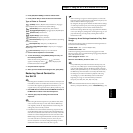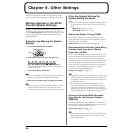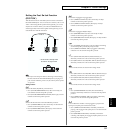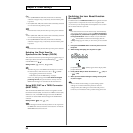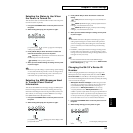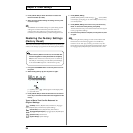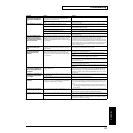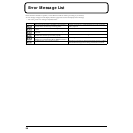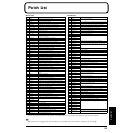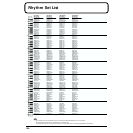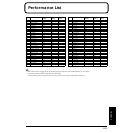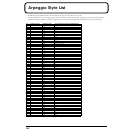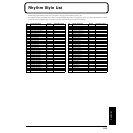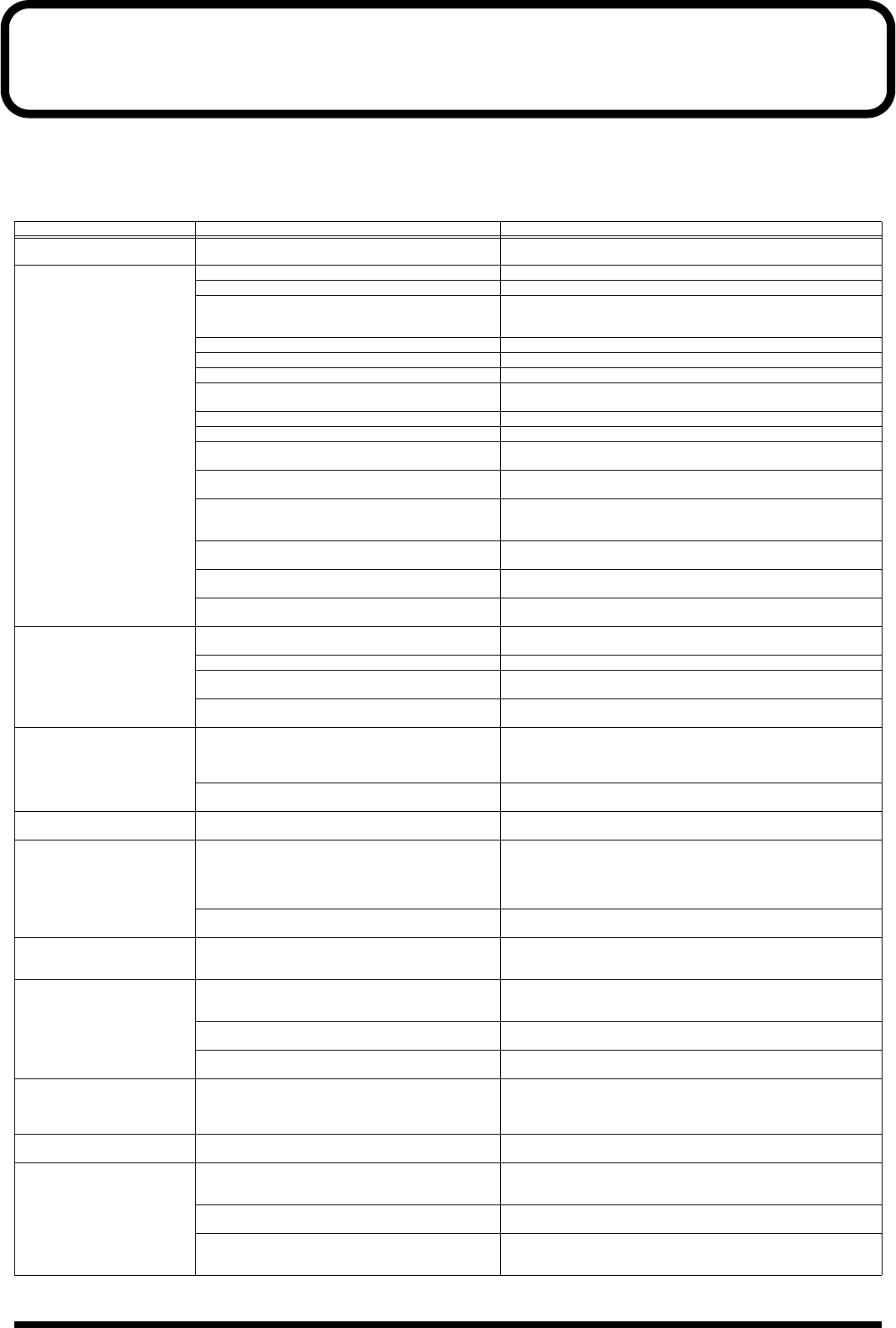
96
Troubleshooting
If the SH-32 stops producing sound, or if it does not function the way you expect, please check the following points first.
If checking these points does not resolve the problem, please contact your dealer or a nearby Roland service center.
* Roland can take no responsibility for the recovery of any lost data, or for any damages incurred as a result of such loss.
Problem Cause Action
Power does not turn on Is the AC adaptor connected correctly to the SH-32 and
to an AC outlet?
Check the AC adaptor connections.
No Sound/Volume is low Is the power of the connected devices turned on? Make sure that the power of your amp or mixer system is turned on.
Is the volume turned down? Check the volume of the SH-32 and of the connected amp or mixer.
Is there sound in the headphones? If there is sound in the headphones, it is possible that the connection
cables are broken, or that the amp or mixer is malfunctioning. Check
the connection cables and your other equipment once again.
Is the Demo Song playback selected? Press [EXIT] to exit Demo Song playback mode (p. 18).
Is the Local Switch turned OFF? Turn the Local Switch ON (p. 90).
Is the Patch or Performance level set too low? Check the [LEVEL] setting (p. 59).
Is the Sustain level of the AMP section set too low? Check the [S] (AMP Env Sustain Level) setting of the AMP section (p.
58).
Is the frequency of the FILTER section set too low? Check the [CUTOFF] setting of the FILTER section (p. 57).
Is the rate of the LFO 1 section set to slow? Check the [RATE] setting of the LFO 1 section (p. 60).
Have volume messages been received from an external
MIDI device to lower the volume?
Check the volume.
Do the transmit channel and the receive channel
match?
Make sure that the transmit and receive channels of the SH-32 and the
external MIDI device match (p. 84).
Is the external MIDI clock reaching the SH-32 (when
CLOCK is set to “MIDI” and the LFO’s BPM SYNC or
Arpeggiator is on)?
Set the external MIDI device so that the MIDI clock is transmitted
properly.
Is the Arpeggio Style (or Rhythm Style) blank (contains
no notes) while Arpeggiator is on?
Either record notes to the Arpeggio Style (or Rhythm Style) or turn off
Arpeggiator.
Is an external MIDI keyboard being used with the RE-
MOTE function turned on and LOCAL set to OFF?
When using the REMOTE function, set LOCAL to ON (p. 90).
Is Slicer or a similar effect selected for INS-FX with an
extremely slow cycle set?
Long periods in which no sound is produced can occur with these
sorts of settings. Check the Rate and other cycle-related settings.
Pitch is wrong Are the Pitch settings of the OSC 1&2 section correct? Check the [COARSE] (Coarse Tune)/[FINE] (Fine Tune) settings of
the OSC 1&2 section (p. 54).
Is the Master Tune setting correct? Check the Master Tune setting (p. 90).
In Performance mode, are the tuning settings for each
Part enabled?
In Part Assign mode, set PITCH [COARSE] and [FINE] to (0).
Has a Pitch Bend message been received from an exter-
nal device, leaving the pitch “hanging?”
Try moving the pitch bend lever of the connected MIDI keyboard.
Notes drop out
(are broken off)
Is Solo/Unison selected? When Solo or Unison is selected, only one note at a time will sound
even if two or more keys are pressed. If you wish to play two or more
notes at a time, press [SOLO] or [UNISON] to make the indicator go
dark, selecting Poly (p. 61, p. 62).
Is the maximum simultaneous polyphony being ex-
ceeded?
The SH-32 has a maximum polyphony of 32 voices. Try seeing if set-
ting Oscillator Reserve can help (p. 73).
Sound is cracked
(distorted)
Has the Patch level or other level been turned up? Check the [LEVEL] setting (p. 59).
A sputtering noise, either pe-
riodic or non-periodic, is au-
dible
Is the pan alternating over a wide range with a rapid
LFO cycle?
The SH-32 is not equipped with any supplemental circuitry (which
makes the connection between level changes smoother) for the pan, so
noise may be generated when the pan changes rapidly or over a wide
angle. If this becomes objectionable, use the INS-FX (Auto Pan Type)
instead of the LFO to control the pan (p. 111).
Is “Lon” (LOFI NOISE) selected as the INS-FX type? This effect type generates simulated analog recorder noise even when
there is no input (this does not indicate a malfunction).
No panning effect Are you using a mono type INS-FX effect? When you use a mono INS-FX, the sound generator’s pan is disabled,
so sound is localized at the center when output. Either turn off INS-FX,
or use a stereo effect.
Sound generator filter not
functioning
Is Oscillator Sync turned on? Oscillator Sync and the sound generator section’s filter cannot be used
at the same time. By selecting Filter as the INS-FX type, you can easily
apply the filter effect.
Is the filter’s ENV DEPTH set to “0” (when only A/D/
S/R is not effective)?
Check the FILTER section’s [ENV DEPTH] setting.
Is the Rhythm Set being edited (when only the SLOPE
cannot be switched)?
The filter’s SLOPE cannot be replaced in Rhythm Sets (it is fixed at -12
dB).
REV/DELAY On/Off and the
individual Parts’ EFFECT
LEVEL sent to REV/DELAY
not effective
Is SEr (Series) selected in the INS > REV Series setting? Set INS > REV Series to PAr (Parallel) and then make the separate set-
tings for each Part (p. 64).
Sync type delay effects not
properly synchronized
Have you exceeded the maximum delay time that can
be set for the selected delay effect?
If the effect is synchronized correctly with shorter delay times, then
use a setting that falls within that range.
Performances using Arpeg-
giator do not start
Has the MIDI clock from an external source been can-
celled (when “MIDI” is selected for the CLOCK set-
ting)?
Set the external MIDI device so that the MIDI clock is correctly trans-
mitted.
Is the Arpeggio Style (or Rhythm Style) blank (contains
no notes)?
Record notes to the Arpeggio Style (or Rhythm Style).
Could it be because the Part to be played as arpeggios
has not been specified (ARPEGGIATOR [ON] flash-
ing)?
Hold down ARPEGGIATOR [ON] and press a Part button to specify
the Part in which arpeggios are to be played.



